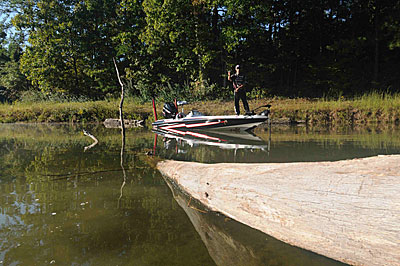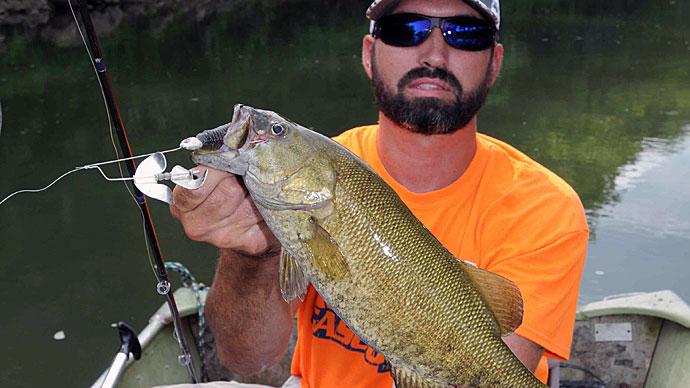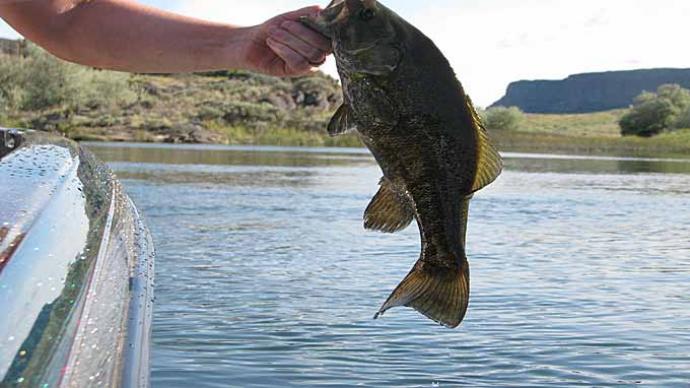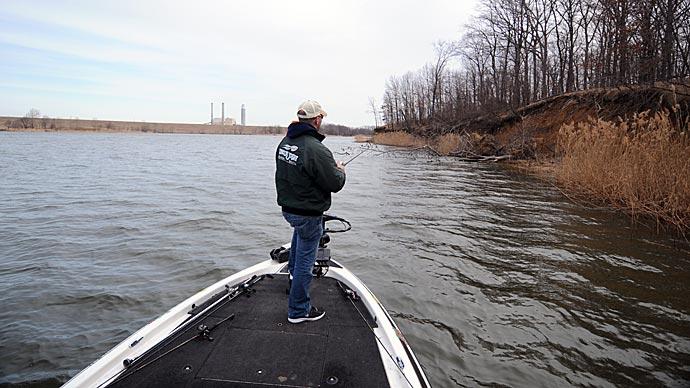
The first hard frost has hit, followed by a spell of cold weather that triggers bass into their fall-feeding frenzy.
The cool, shallow, polar air mass converts into a deep, warm, stagnant high-pressure system, which has the effect of causing haze and large swings in temperatures between day and night. A prolonged fall weather pattern featuring warm, calm days with high pressure and clear and chilly nights cause baitfish and bass to change their typical fall migration to the backs of creeks and coves.
This weather phenomenon known as Indian summer becomes a tough time for bass anglers to find fish because of the drastic changes in the daytime and nighttime temperatures. “It scatters the bass really bad,” Bassmaster Elite Series pro John Crews says. “You will have fish in 6 inches of water, fish in 6 feet of water, and fish in 30 feet of water. And then there will still be fish suspended out in the middle of the lake chasing baitfish, and a lot of fish are not relating to cover. So it splits up the fish because they are almost everywhere when that happens.”
Indian summer also has the same effect on baitfish. “When you first start to get that cooler weather, a lot of the baitfish and the bass both go shallower, so it reduces many possibilities of where the fish are,” Crew says. “But when the bait is scattered deep and suspended, it scatters the bass and makes them hard to target.”
Crews suggests you must adjust when Indian summer occurs on your favorite lake. One of Crews’ favorite tactics for Indian summer bass is to move shallow and target resident fish that remain shallow all the time. He also looks for locations that are harder to access, such as way up a river or the back of a creek or pocket. “Hard-to-reach fish is especially a good strategy when Indian summer happens,” he says. “As a general rule, the upper ends of a lake usually have harder to reach areas in creeks and rivers coming in, but you can have a creek arm on the lower end of the lake that is harder to access or that goes back a long way too and might have resident fish.”
Areas requiring a difficult cast, such as skipping a bait a long way under a dock, are also ideal for targeting Indian summer bass. Crews advises that docks with hard-to-reach spots can be great places to find Indian summer bass in thin water.
Although bass can be anywhere in a lake during Indian summer, Crews believes targeting shallow fish is the easiest approach for catching the most bass. “You can go deep, but you are going to pick off a lot of single fish because deep fish are not schooled up that time of year,” he says. The Virginia pro admits shallow resident bass are also single fish but are usually easier to catch than trying to pinpoint single fish in deep water.

A topwater walking bait is one of Crews’ favorite lures for throwing in ultra-shallow water. He retrieves the surface plug with a steady retrieve, allowing him to cover water quickly and pick off any bass cruising the shallows.
“If you see any kind of schooling activity or a lot of baitfish, pick up the topwater no matter what time of day it is,” Crews says. He advises shallow bass will pounce on the surface plug even in bright sunshine.
A wacky-rigged Missile Baits "The 48" stick worm is another lure Crews relies on to catch Indian summer bass. He suggests you can make the bait “skip a mile” under a boat dock or overhanging tree limbs.
Drop-shotting, a Missile Baits Bomb Shot in open water or around sparse cover, also produces Indian summer bass for Crews. Crews rigs the finesse worm Texas style when fishing around cover on a Number 1 Gamakatsu extra wide gap hook with a 1/8-ounce weight set 6 to 8 inches below the worm. “You can catch a bunch of fish around cover with that thing,“ he says. “I just kind of drag it along. With that lighter weight, I want to keep it bouncing along the bottom. Then when I get it around where I think a bass is, I just let it sit there and shake it a little bit on slack line. It doesn’t take much of a shake. If the fish are around it, they will eat it.”
Shallow cover is scarce during Indian summer because lakes are usually low then, but if Crews finds some laydowns or thick cover, he will pitch a Missile Baits Baby D Stroyer to the targets. “The Baby D Stroyer is a smaller creature bait, and it has excellent action,” Crews says. He Texas-rigs the creature bait on a 3/0 Gamakatsu Heavy Cover Worm Hook and a 1/4-ounce worm weight and pitches it on 20-pound Sunline Shooter Fluorocarbon line.
Crews’ strategy for fishing Indian summer days is to start in the morning with a topwater bait when the water is still cool from the chilly night. Then as the sun gets higher and the water warms up by mid-day, he switches to the drop-shot rig or pitching into cover.
BassResource may receive a portion of revenues if you make a purchase using a link above.




